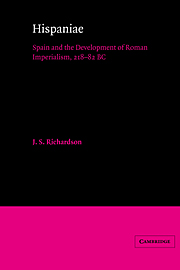Book contents
- Frontmatter
- Contents
- List of maps
- Preface
- Abbreviations
- 1 Spain and Roman imperialism
- 2 Spain before the Romans
- 3 The war zone: 218–206
- 4 Continuity and adaptation: 206–194
- 5 The shaping of the provinciae: 193–155
- 6 The consular provinciae: the wars in Spain 155–133
- 7 From provinciae to provinces: 133–82
- 8 Rome, Spain and imperialism
- Appendices
- Bibliography
- Index
5 - The shaping of the provinciae: 193–155
Published online by Cambridge University Press: 07 September 2009
- Frontmatter
- Contents
- List of maps
- Preface
- Abbreviations
- 1 Spain and Roman imperialism
- 2 Spain before the Romans
- 3 The war zone: 218–206
- 4 Continuity and adaptation: 206–194
- 5 The shaping of the provinciae: 193–155
- 6 The consular provinciae: the wars in Spain 155–133
- 7 From provinciae to provinces: 133–82
- 8 Rome, Spain and imperialism
- Appendices
- Bibliography
- Index
Summary
The praetorian commanders 193–155
Cato claimed that, by the end of his tenure of the provincia of Hispania Citerior, the area was at peace. The senate, in recognition of this, voted him a three-day supplicatio in thanksgiving to the gods and, on his return, a triumph. They also decided that the army which Cato had commanded in Spain, consisting of two legions with the usual complement of auxiliary infantry and cavalry, should be withdrawn. Although the wisdom of this action has been questioned, it was an inevitable concomitant of the senate's acceptance of Cato's account of his own successes, and the award of a triumph. However, as the following years demonstrated, the senate was undoubtedly wrong to believe Cato.
Both the praetors sent out to Spain in 194 had connections with the peninsula. P. Cornelius Scipio Nasica, who was sent to Ulterior, was the son of Cn. Scipio who had been killed with his brother Publius in the disasters of 211. Sex. Digitius was present with Publius' son, the younger P. Scipio, at New Carthage in 209, where, as a socius navalis, he won the distinction of a mural crown, and in all probability gained the citizenship. In 194, in the second consulship of P. Scipio, Nasica's cousin and Digitius' former commander, these two men were faced with the aftermath of Cato's victories. Digitius succeeded Cato, and, with forces less than half those at his predecessor's disposal, had to deal with a rash of small-scale rebellions.
- Type
- Chapter
- Information
- HispaniaeSpain and the Development of Roman Imperialism, 218–82 BC, pp. 95 - 125Publisher: Cambridge University PressPrint publication year: 1986

